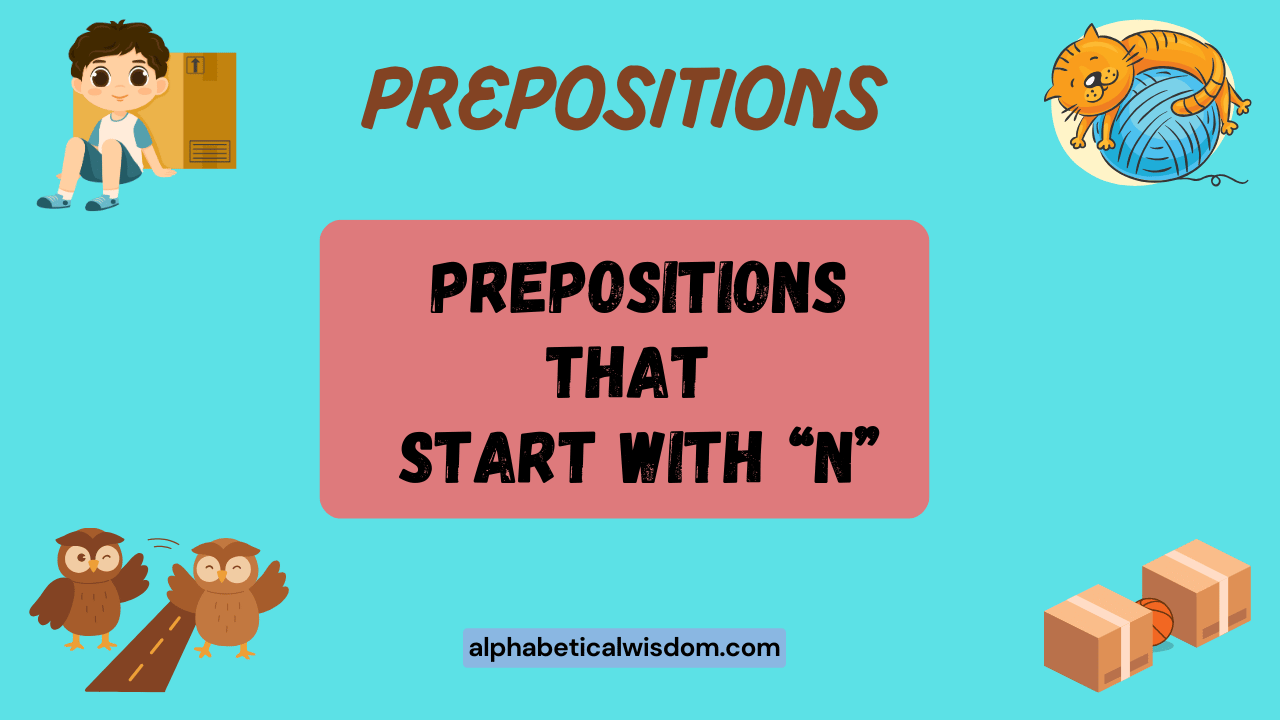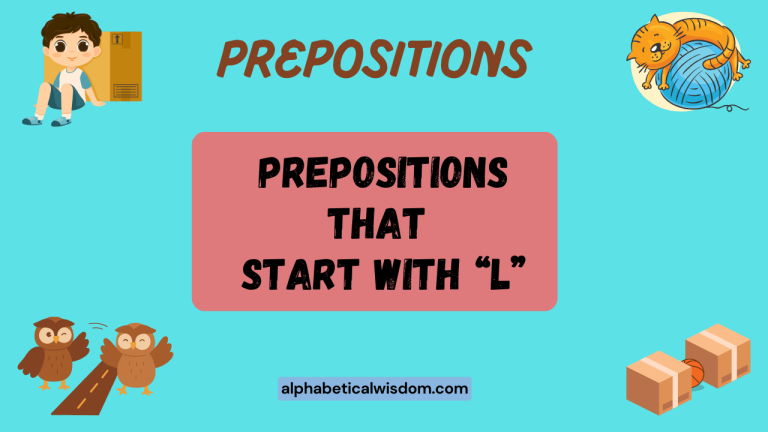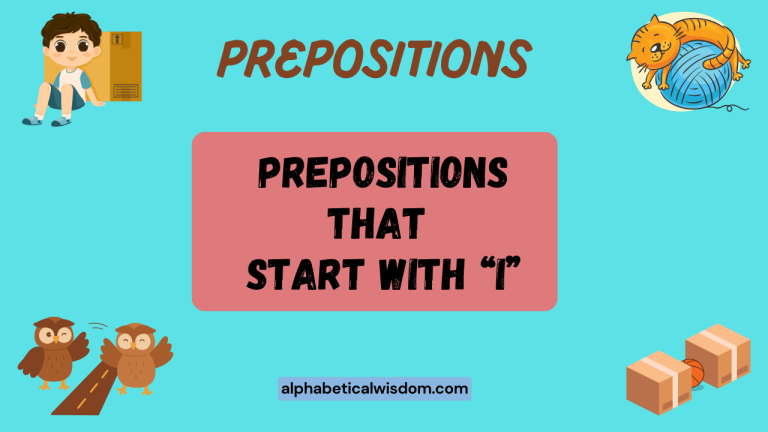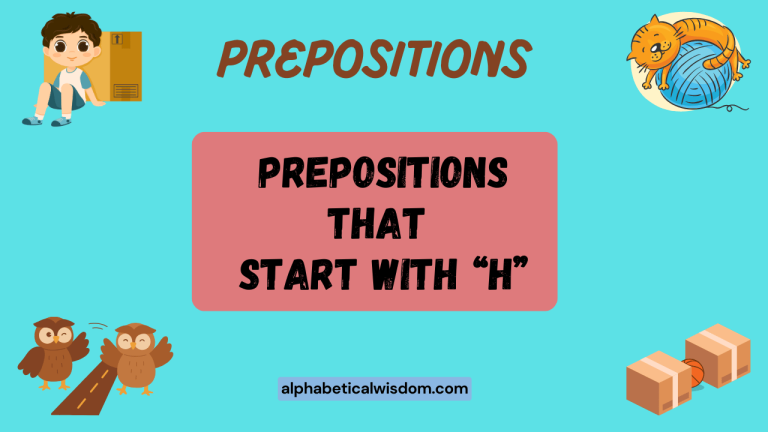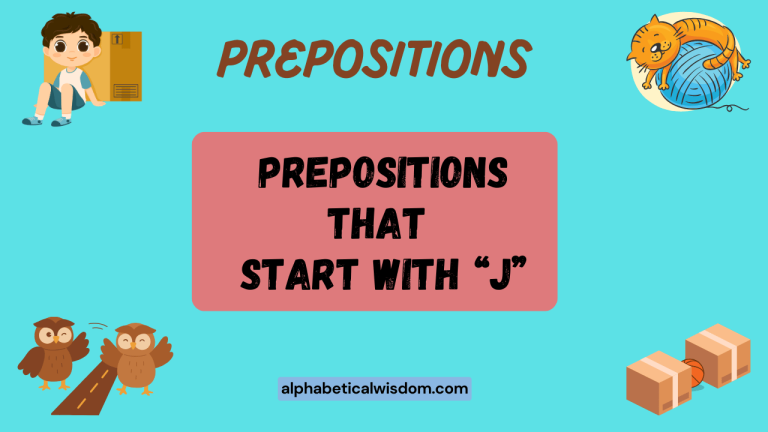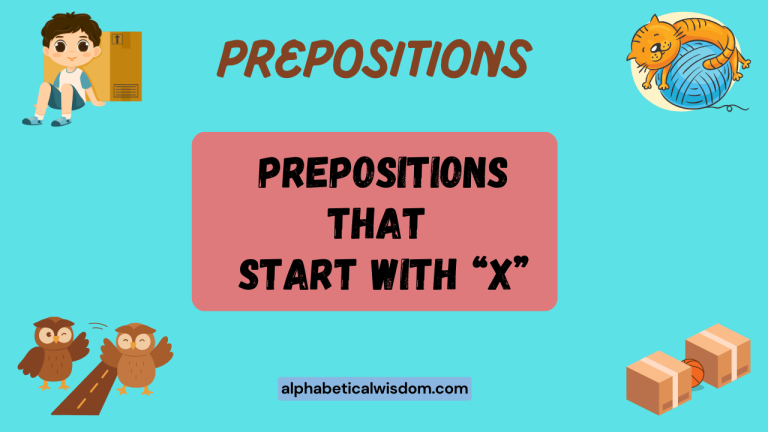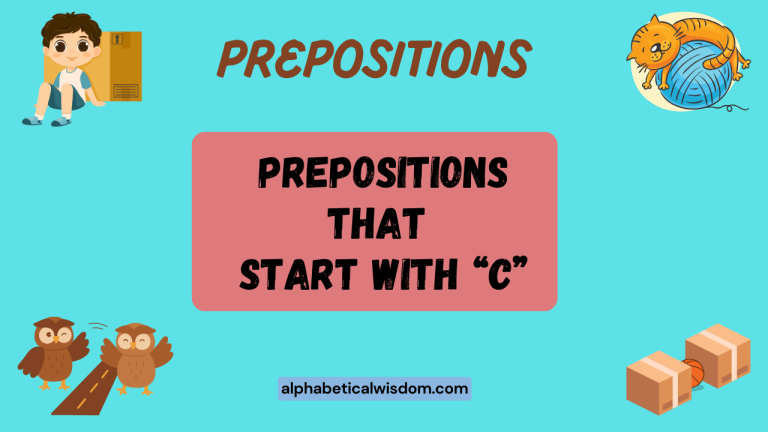Prepositions Starting with ‘N’: A Comprehensive Guide
Mastering prepositions is crucial for constructing clear and grammatically correct sentences in English. While some prepositions are more commonly used, others, like those starting with the letter ‘N,’ might seem less frequent but are equally important.
Understanding these prepositions enhances your ability to express nuanced relationships between elements in a sentence. This article provides a comprehensive guide to prepositions that begin with ‘N,’ offering definitions, examples, usage rules, and practice exercises.
Whether you’re an English language learner or a seasoned writer, this guide will help you confidently use these prepositions and improve your overall grammar skills.
Table of Contents
- Introduction
- Definition of Prepositions
- Structural Breakdown
- Types of Prepositions
- Examples of Prepositions Starting with ‘N’
- Usage Rules
- Common Mistakes
- Practice Exercises
- Advanced Topics
- FAQ
- Conclusion
Introduction
Prepositions are essential components of English grammar, acting as bridges between nouns, pronouns, and other words in a sentence. They specify relationships of time, location, direction, and more.
While common prepositions like “in,” “on,” and “at” are frequently used, prepositions starting with the letter ‘N’—such as “near,” “next,” “nigh,” and “notwithstanding”—add depth and precision to our language. This article delves into the nuances of these ‘N’ prepositions, providing detailed explanations and examples to help you understand and use them effectively.
Whether you’re a student, a writer, or simply someone looking to improve their English skills, this guide offers valuable insights and practical exercises to enhance your grasp of these important grammatical elements.
Definition of Prepositions
A preposition is a word that connects a noun, pronoun, or noun phrase to other words in a sentence. It typically indicates the spatial, temporal, or logical relationship of the noun phrase to the rest of the sentence. Prepositions usually precede the noun or pronoun, which is then called the object of the preposition. Together, the preposition and its object form a prepositional phrase. Prepositions are crucial for conveying meaning and providing context within sentences. They help describe where things are, when events happen, and how different elements relate to each other.
Classification of Prepositions
Prepositions can be classified based on their form and function. Simple prepositions consist of a single word (e.g., in, on, at). Compound prepositions are formed by two or more words (e.g., according to, because of). Prepositions can also be categorized by the type of relationship they express, such as time, place, direction, or manner. Understanding these classifications helps in correctly identifying and using prepositions in various contexts.
Function of Prepositions
The primary function of a preposition is to show the relationship between a noun or pronoun and other words in the sentence. This relationship can be spatial (e.g., the book is on the table), temporal (e.g., we arrived before noon), or abstract (e.g., she is interested in art). Prepositions also play a vital role in forming phrases that act as adjectives or adverbs, providing additional details about the nouns or verbs they modify. The correct use of prepositions is essential for clear and accurate communication.
Contexts of Prepositions
Prepositions are used in a wide range of contexts, from everyday conversation to formal writing. They appear in descriptive sentences, instructions, narratives, and arguments.
The specific preposition chosen depends on the intended meaning and the relationship being described. For example, “near” might be used to indicate proximity in location, while “notwithstanding” might be used to introduce a contrasting idea.
Recognizing the appropriate context for each preposition is key to effective communication.
Structural Breakdown
The structure involving prepositions is relatively straightforward. A preposition typically precedes a noun or pronoun, forming a prepositional phrase.
This phrase can function as an adjective, modifying a noun, or as an adverb, modifying a verb, adjective, or another adverb. The object of the preposition is the noun or pronoun that follows the preposition.
Understanding this basic structure helps in identifying and analyzing the role of prepositions within sentences.
The basic formula can be represented as: Preposition + (Optional Modifiers) + Noun/Pronoun. For example, in the phrase “near the old oak tree,” “near” is the preposition, “the old” are the modifiers, and “oak tree” is the noun.
Prepositional Phrases
A prepositional phrase consists of a preposition and its object, along with any modifiers. These phrases add detail and context to sentences. They can function as adjectives, describing nouns (e.g., the house with the blue door), or as adverbs, modifying verbs, adjectives, or other adverbs (e.g., he walked with determination). Recognizing the function of prepositional phrases is essential for understanding sentence structure and meaning.
Objects of Prepositions
The object of a preposition is the noun or pronoun that the preposition governs. It is the word or phrase that follows the preposition and completes its meaning. The object of a preposition can be a simple noun (e.g., to the store), a pronoun (e.g., for him), or a noun phrase (e.g., in the middle of the night). Identifying the object of the preposition is crucial for understanding the relationship being expressed.
Modifiers in Prepositional Phrases
Prepositional phrases can include modifiers that further describe the object of the preposition. These modifiers typically come before the noun or pronoun and can include adjectives, adverbs, or other descriptive words.
For example, in the phrase “near the big, old house,” the adjectives “big” and “old” modify the noun “house.” These modifiers add detail and precision to the prepositional phrase.
Types of Prepositions
Prepositions can be categorized based on their meaning and the type of relationship they express. Common categories include prepositions of time, place, direction, and manner.
This section focuses on prepositions starting with ‘N’ and their specific uses.
Prepositions of Place
Prepositions of place indicate the location or position of something in relation to another object or place. Examples of prepositions starting with ‘N’ that indicate place include “near,” “next to,” and “nigh.” These prepositions help describe the spatial relationships between different elements in a sentence.
For instance, “The park is near the school” indicates that the park is located close to the school.
Prepositions of Direction
Prepositions of direction indicate movement or orientation towards a specific location. While prepositions starting with ‘N’ are less commonly used to express direction, they can still convey a sense of movement or orientation in certain contexts.
For example, one might say, “They journeyed nigh the mountain,” indicating they moved in the direction of the mountain.
Other Prepositions Starting with ‘N’
Some prepositions starting with ‘N’ do not fit neatly into the categories of place or direction but serve other functions. For example, “notwithstanding” is used to introduce a statement that contrasts with or qualifies a previous statement.
These prepositions add complexity and nuance to language.
Examples of Prepositions Starting with ‘N’
This section provides extensive examples of prepositions starting with ‘N’ used in various contexts. Understanding these examples will help you grasp the nuances of each preposition and use them correctly in your own writing and speech.
Examples using “Near”
The preposition “near” indicates proximity or closeness in space or time. It is commonly used to describe the location of one object in relation to another.
The following table provides several examples of “near” used in different contexts.
| Sentence | Explanation |
|---|---|
| The store is near the bank. | Indicates the store is located close to the bank. |
| We live near the beach. | Indicates the speaker’s residence is close to the beach. |
| The children were playing near the river. | Indicates the children were playing close to the river. |
| Her birthday is near Christmas. | Indicates her birthday is close in time to Christmas. |
| They sat near the fireplace. | Indicates they were sitting close to the fireplace. |
| The cat is sleeping near the window. | Indicates the cat is sleeping close to the window. |
| The restaurant is near the hotel. | Indicates the restaurant is located close to the hotel. |
| The post office is near the library. | Indicates the post office is located close to the library. |
| The school is near the park. | Indicates the school is located close to the park. |
| The hospital is near the city center. | Indicates the hospital is located close to the city center. |
| The bakery is near the coffee shop. | Indicates the bakery is located close to the coffee shop. |
| The museum is near the art gallery. | Indicates the museum is located close to the art gallery. |
| The airport is near the industrial area. | Indicates the airport is located close to the industrial area. |
| The gas station is near the highway. | Indicates the gas station is located close to the highway. |
| The stadium is near the sports complex. | Indicates the stadium is located close to the sports complex. |
| The zoo is near the botanical gardens. | Indicates the zoo is located close to the botanical gardens. |
| The concert is near the end of the month. | Indicates the concert is scheduled close to the end of the month. |
| The deadline is near the end of the week. | Indicates the deadline is approaching the end of the week. |
| The meeting is near lunchtime. | Indicates the meeting is scheduled close to lunchtime. |
| The vacation is near the summer holidays. | Indicates the vacation is scheduled close to the summer holidays. |
| The New Year is near. | Indicates the New Year is approaching soon. |
| The exam is near. | Indicates the exam is approaching soon. |
| The party is near. | Indicates the party is happening soon. |
| The arrival is near. | Indicates the arrival will happen soon. |
| The end is near. | Indicates the end is approaching soon. |
Examples using “Next to”
The preposition “next to” indicates that something is immediately beside another object or person. It specifies a closer proximity than “near.” The following table provides examples of “next to” in different contexts.
| Sentence | Explanation |
|---|---|
| She sat next to him on the bus. | Indicates she was sitting immediately beside him on the bus. |
| The bank is next to the post office. | Indicates the bank is located immediately beside the post office. |
| He parked his car next to mine. | Indicates his car was parked immediately beside the speaker’s car. |
| The coffee shop is next to the bakery. | Indicates the coffee shop is located immediately beside the bakery. |
| The lamp is next to the bed. | Indicates the lamp is placed immediately beside the bed. |
| The park is next to the school. | Indicates the park is situated immediately beside the school. |
| The restaurant is next to the cinema. | Indicates the restaurant is located immediately beside the cinema. |
| The supermarket is next to the library. | Indicates the supermarket is situated immediately beside the library. |
| The gas station is next to the car wash. | Indicates the gas station is located immediately beside the car wash. |
| The bookstore is next to the clothing store. | Indicates the bookstore is situated immediately beside the clothing store. |
| The pharmacy is next to the doctor’s office. | Indicates the pharmacy is located immediately beside the doctor’s office. |
| The playground is next to the community center. | Indicates the playground is situated immediately beside the community center. |
| The art gallery is next to the museum. | Indicates the art gallery is located immediately beside the museum. |
| The fitness center is next to the swimming pool. | Indicates the fitness center is situated immediately beside the swimming pool. |
| The concert hall is next to the theater. | Indicates the concert hall is located immediately beside the theater. |
| The airport is next to the train station. | Indicates the airport is situated immediately beside the train station. |
| The courthouse is next to the police station. | Indicates the courthouse is located immediately beside the police station. |
| The university is next to the research institute. | Indicates the university is situated immediately beside the research institute. |
| The factory is next to the warehouse. | Indicates the factory is located immediately beside the warehouse. |
| The farm is next to the orchard. | Indicates the farm is situated immediately beside the orchard. |
| The beach is next to the boardwalk. | Indicates the beach is located immediately beside the boardwalk. |
| The river is next to the forest. | Indicates the river is situated immediately beside the forest. |
| The lake is next to the mountain. | Indicates the lake is located immediately beside the mountain. |
| The garden is next to the patio. | Indicates the garden is situated immediately beside the patio. |
| The desk is next to the window. | Indicates the desk is located immediately beside the window. |
Examples using “Nigh”
The preposition “nigh” is an archaic term that means “near” or “close to.” It is less commonly used in modern English but can still be found in literature and formal writing. The following table provides examples of “nigh” used in different contexts.
| Sentence | Explanation |
|---|---|
| The hour of reckoning is nigh. | Indicates the time of reckoning is near. |
| Winter is nigh. | Indicates winter is approaching. |
| The village was nigh the forest. | Indicates the village was located near the forest. |
| The end of the journey was nigh. | Indicates the end of the journey was near. |
| Night was nigh when they reached the inn. | Indicates it was nearly night when they arrived at the inn. |
| The storm was nigh. | Indicates the storm was approaching. |
| The kingdom was nigh the mountains. | Indicates the kingdom was located near the mountains. |
| The celebration was nigh. | Indicates the celebration was soon to happen. |
| The completion of the project was nigh. | Indicates the project was nearing completion. |
| The treasure was hidden nigh the ancient ruins. | Indicates the treasure was hidden near the ancient ruins. |
| The dawn was nigh. | Indicates the dawn was approaching. |
| The summit was nigh. | Indicates the summit was close. |
| The battle was nigh. | Indicates the battle was impending. |
| The ship was nigh the harbor. | Indicates the ship was close to the harbor. |
| The destination was nigh. | Indicates the destination was near. |
| The festival was nigh. | Indicates the festival was approaching. |
| The escape was nigh. | Indicates the escape was close. |
| The solution was nigh. | Indicates the solution was near. |
| The confrontation was nigh. | Indicates the confrontation was approaching. |
| The alliance was nigh. | Indicates the alliance was close to being formed. |
| The train was nigh. | Indicates the train was approaching. |
| The revelation was nigh. | Indicates the revelation was coming soon. |
| The discovery was nigh. | Indicates the discovery was close. |
| The triumph was nigh. | Indicates the triumph was approaching. |
| The reconciliation was nigh. | Indicates the reconciliation was near. |
Examples using “Notwithstanding”
The preposition “notwithstanding” means “in spite of” or “despite.” It is used to introduce a statement that contrasts with or qualifies a previous statement. It is often used in formal writing and legal contexts.
The following table provides examples of “notwithstanding” used in different contexts.
| Sentence | Explanation |
|---|---|
| Notwithstanding the rain, we decided to go for a walk. | Indicates that despite the rain, they went for a walk. |
| Notwithstanding his efforts, he failed the exam. | Indicates that despite his efforts, he failed the exam. |
| Notwithstanding the difficulties, they persevered. | Indicates that despite the difficulties, they continued to persevere. |
| Notwithstanding her age, she is very active. | Indicates that despite her age, she is very active. |
| Notwithstanding the evidence, he maintained his innocence. | Indicates that despite the evidence, he insisted on his innocence. |
| Notwithstanding the cost, they bought the house. | Indicates that despite the cost, they purchased the house. |
| Notwithstanding the risks, they proceeded with the plan. | Indicates that despite the risks, they moved forward with the plan. |
| Notwithstanding the challenges, they achieved their goals. | Indicates that despite the challenges, they reached their objectives. |
| Notwithstanding the criticism, she continued her work. | Indicates that despite the criticism, she persisted with her work. |
| Notwithstanding the delay, the project was completed on time. | Indicates that despite the delay, the project finished as scheduled. |
| Notwithstanding the warnings, he ignored the advice. | Indicates that despite the warnings, he disregarded the advice. |
| Notwithstanding the setbacks, they remained optimistic. | Indicates that despite the setbacks, they stayed hopeful. |
| Notwithstanding the complaints, the company continued its operations. | Indicates that despite the complaints, the company continued operating. |
| Notwithstanding the opposition, the law was passed. | Indicates that despite the opposition, the law was enacted. |
| Notwithstanding the limitations, they made the most of the situation. | Indicates that despite the limitations, they maximized the situation. |
| Notwithstanding the obstacles, they found a way to succeed. | Indicates that despite the obstacles, they managed to succeed. |
| Notwithstanding the complexity, they understood the problem. | Indicates that despite the complexity, they comprehended the problem. |
| Notwithstanding the difficulties, they learned a lot. | Indicates that despite the difficulties, they gained significant knowledge. |
| Notwithstanding the rumors, they trusted their friend. | Indicates that despite the rumors, they had faith in their friend. |
| Notwithstanding the differences, they worked well together. | Indicates that despite the differences, they cooperated effectively. |
| Notwithstanding the regulations, they innovated. | Indicates that despite the regulations, they were innovative. |
| Notwithstanding the circumstances, they adapted. | Indicates that despite the circumstances, they adjust. |
| Notwithstanding the predictions, they flourished. | Indicates that despite the predictions, they were prosperous. |
| Notwithstanding the challenges, they grew. | Indicates that despite the challenges, they developed. |
| Notwithstanding the shortcomings, they improved. | Indicates that despite the shortcomings, they progressed. |
Usage Rules
Using prepositions correctly involves understanding their specific meanings and the contexts in which they are appropriate. This section outlines the usage rules for prepositions starting with ‘N,’ including exceptions and special cases.
“Near” Usage Rules
The preposition “near” is used to indicate proximity in space or time. It is followed by a noun or noun phrase.
“Near to” is also acceptable but less common in modern English. Avoid using “near” in situations where “next to” is more appropriate, as “next to” implies a closer proximity.
“Next To” Usage Rules
The preposition “next to” indicates that something is immediately beside another object or person. It is more specific than “near.” It is important to ensure that the objects or people being described are indeed adjacent to each other.
“Next to” can also be used figuratively to indicate sequence or order.
“Nigh” Usage Rules
The preposition “nigh” is archaic and less commonly used in modern English. It is typically reserved for formal or literary contexts.
When using “nigh,” ensure that the tone and style of the writing are consistent with its archaic nature. It can often be replaced with “near” or “close to” in contemporary writing.
“Notwithstanding” Usage Rules
The preposition “notwithstanding” is used to introduce a statement that contrasts with or qualifies a previous statement. It is typically used in formal writing and legal contexts.
It is often followed by a noun or noun phrase. “Notwithstanding” can also be used as an adverb, meaning “nevertheless.”
Common Mistakes
Even experienced English speakers sometimes make mistakes with prepositions. This section addresses common errors made with prepositions starting with ‘N’ and provides correct examples.
Mistakes with “Near”
A common mistake is using “near” when “next to” is more appropriate. “Near” indicates general proximity, while “next to” indicates immediate adjacency.
- Incorrect: The chair is near to the table. (when the chair is right beside the table)
- Correct: The chair is next to the table.
Mistakes with “Next To”
A common mistake is using “next to” when the objects are not actually adjacent but merely in the vicinity.
- Incorrect: The school is next to the park. (when the school and park are in the same area, but not directly beside each other)
- Correct: The school is near the park.
Mistakes with “Nigh”
Using “nigh” in informal contexts can sound awkward or pretentious. It is best reserved for formal writing or literary works.
- Incorrect: The store is nigh my house. (in casual conversation)
- Correct: The store is near my house.
Mistakes with “Notwithstanding”
A common mistake is using “notwithstanding” in place of simpler alternatives like “despite” or “in spite of” in informal writing.
- Incorrect: Notwithstanding the rain, we went out. (in casual writing)
- Correct: Despite the rain, we went out.
Practice Exercises
Test your understanding of prepositions starting with ‘N’ with these practice exercises. Choose the correct preposition to complete each sentence.
Exercise 1: Fill in the Blanks
Instructions: Choose the correct preposition (“near,” “next to,” or “notwithstanding”) to complete each sentence.
| Question | Answer |
|---|---|
| 1. The library is ______ the post office. | near |
| 2. The coffee shop is ______ the bookstore. | next to |
| 3. ______ the difficulties, they succeeded. | Notwithstanding |
| 4. The park is ______ the school. | near |
| 5. She sat ______ him on the bench. | next to |
| 6. ______ his efforts, he failed. | Notwithstanding |
| 7. The bank is ______ the grocery store. | near |
| 8. The museum is ______ the art gallery. | next to |
| 9. ______ the rain, they continued their hike. | Notwithstanding |
| 10. The playground is ______ the community center. | near |
Exercise 2: Sentence Completion
Instructions: Complete the following sentences using an appropriate prepositional phrase starting with “near,” “next to,” or “notwithstanding.”
| Question | Answer |
|---|---|
| 1. The cat is sleeping ______ . | near the fireplace |
| 2. The restaurant is located ______ . | next to the movie theater |
| 3. ______, they decided to proceed. | Notwithstanding the risks |
| 4. The children were playing ______ . | near the riverbank |
| 5. The office is situated ______ . | next to the elevator |
| 6. ______, she remained optimistic. | Notwithstanding the setbacks |
| 7. The store is conveniently located ______ . | near the bus stop |
| 8. The bakery is ______. | next to the coffee shop |
| 9. ______, the project was completed on time. | Notwithstanding the delays |
| 10. The school is ______ . | near the local park |
Exercise 3: Error Correction
Instructions: Identify and correct the errors in the following sentences.
| Question | Answer |
|---|---|
| 1. The house is next my office. | The house is near my office. |
| 2. Near to his efforts, he still failed. | Notwithstanding his efforts, he still failed. |
| 3. The library is nigh the school. (in casual conversation) | The library is near the school. |
| 4. Notwithstanding the sun, it was cold. | Despite/In spite of the sun, it was cold. |
| 5. The coffee shop is near to the bakery. (when they are right beside each other) | The coffee shop is next to the bakery. |
| 6. Next to the problems, they succeeded. | Notwithstanding the problems, they succeeded. |
| 7. The beach is nigh my house(in conversation) | The beach is near my house. |
| 8. Near the difficulties, they still won. | Notwithstanding the difficulties, they still won. |
| 9. The store is next the bank. | The store is near the bank. |
| 10. The hour is nigh! (in casual conversation) | The hour is near! |
Advanced Topics
For advanced learners, understanding the nuances of prepositions involves exploring their historical usage, idiomatic expressions, and subtle differences in meaning. This section delves into these advanced topics.
Historical Usage of “Nigh”
The preposition “nigh” has a rich history, dating back to Old English. It was more commonly used in earlier periods of English literature and language.
Studying its historical usage provides insight into the evolution of the English language and the changing meanings of words over time. Understanding the etymology and historical context of “nigh” can enhance appreciation for its literary and formal applications.
Idiomatic Expressions with “Near”
While “near” is primarily a preposition of place or time, it also appears in various idiomatic expressions. These expressions have figurative meanings that go beyond the literal sense of proximity.
For example, “near and dear” means cherished or beloved. Understanding these idiomatic expressions adds depth to one’s understanding of the English language.
Subtle Differences between “Near” and “Next To”
Although “near” and “next to” both indicate proximity, they convey slightly different meanings. “Near” implies a general closeness, while “next to” implies immediate adjacency.
Recognizing these subtle differences is crucial for precise communication. Choosing the appropriate preposition depends on the specific relationship being described.
FAQ
This section addresses frequently asked questions about prepositions starting with ‘N,’ providing clear and concise answers.
- What is the difference between “near” and “next to”?
While both indicate proximity, “near” implies general closeness, whereas “next to” implies immediate adjacency. For example, “The park is near the school” means the park is in the vicinity of the school, while “The park is next to the school” means the park is right beside the school.
- When should I use “nigh” instead of “near”?
“Nigh” is an archaic term and is best reserved for formal or literary contexts. In modern English, “near” is generally preferred in everyday conversation and writing. Using “nigh” in informal settings can sound pretentious.
- Can “notwithstanding” be used in informal writing?
While grammatically correct, “notwithstanding” is typically used in formal writing and legal contexts. In informal writing, simpler alternatives like “despite” or “in spite of” are often more appropriate.
- Is “near to” always interchangeable with “near”?
While “near to” is grammatically correct, “near” is more common in modern English. “Near to” can sometimes sound slightly
, but both can be used to indicate proximity.
- How do I avoid mistakes with prepositions?
To avoid mistakes with prepositions, it’s essential to understand their specific meanings and the contexts in which they are appropriate. Practice using prepositions in various sentences and pay attention to how native speakers use them. Reviewing common errors and doing exercises can also help improve accuracy.
Conclusion
Mastering prepositions starting with ‘N’ enhances your ability to express nuanced relationships in English. While some of these prepositions, like “nigh,” are less common in modern usage, understanding their meanings and appropriate contexts can add depth to your language skills.
By studying the examples, usage rules, and common mistakes outlined in this guide, you can confidently use prepositions like “near,” “next to,” and “notwithstanding” to improve your overall grammar and communication skills. Continuous practice and attention to detail will further solidify your understanding and mastery of these essential grammatical elements.
